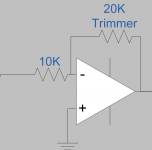Hi everyone, I am curious about something.
I have been using the attached picture lately as a simple buffer circuit to control levels within the preamp/EQ projects I've been making lately. I'm wondering if this simple buffer circuit is better than just using an in line variable resistor. Better in that it will have lower distortion/noise. Or is there no measurable difference between the two?
I'm guessing that some op amps might have a problem with stability in doing fractional gain when attenuating signals with this circuit. When I've used the OPA2134's it seems stable and with low noise but recently I ran into a weird problem using this circuit for feedback in a filter circuit. The good old in line resistor method worked fine but when I tried this buffer attenuator/booster for the feedback, things got pretty unstable. I don't understand why.
Advice is welcomed.
I have been using the attached picture lately as a simple buffer circuit to control levels within the preamp/EQ projects I've been making lately. I'm wondering if this simple buffer circuit is better than just using an in line variable resistor. Better in that it will have lower distortion/noise. Or is there no measurable difference between the two?
I'm guessing that some op amps might have a problem with stability in doing fractional gain when attenuating signals with this circuit. When I've used the OPA2134's it seems stable and with low noise but recently I ran into a weird problem using this circuit for feedback in a filter circuit. The good old in line resistor method worked fine but when I tried this buffer attenuator/booster for the feedback, things got pretty unstable. I don't understand why.
Advice is welcomed.
Attachments
That buffer can amplify as well as attenuate, and will probably have a more complex frequency response than a potential divider. Simply putting a variable resistor in series with the signal is a poor way to attenuate, as it raises impedance too and so creates problems with any stray capacitance.
Active feedback circuits can get complicated. You need to be well up to speed on feedback and stability theory before using them.
The best way to attenuate a signal is with a potential divider, using appropriate resistor values.
Active feedback circuits can get complicated. You need to be well up to speed on feedback and stability theory before using them.
The best way to attenuate a signal is with a potential divider, using appropriate resistor values.
- Status
- This old topic is closed. If you want to reopen this topic, contact a moderator using the "Report Post" button.
